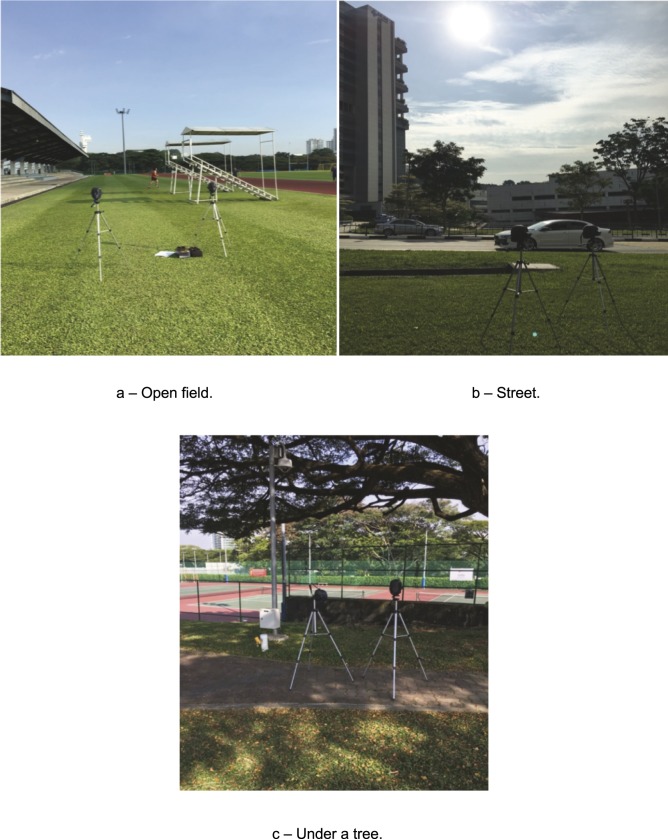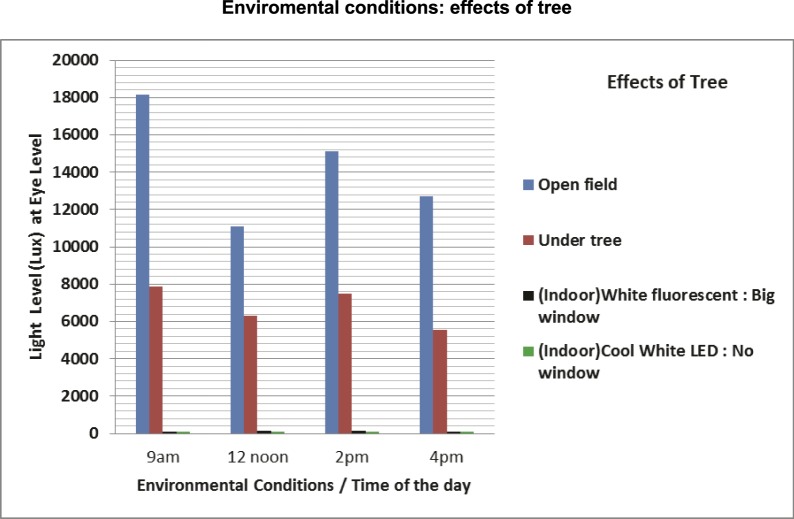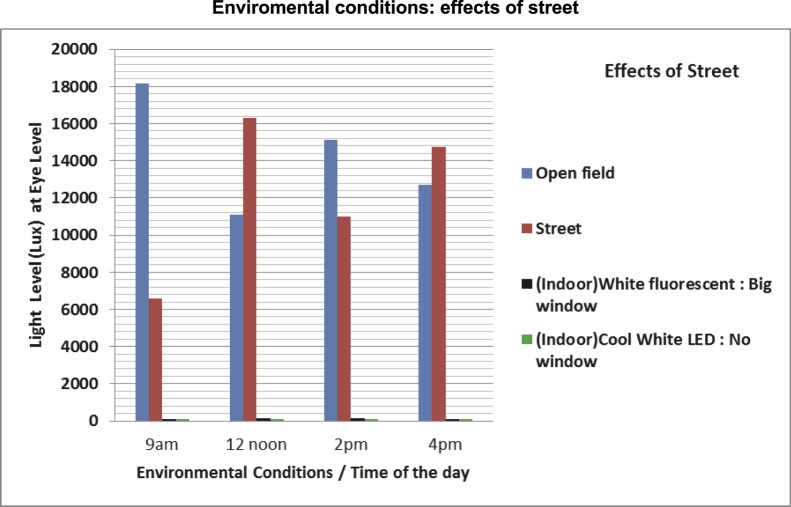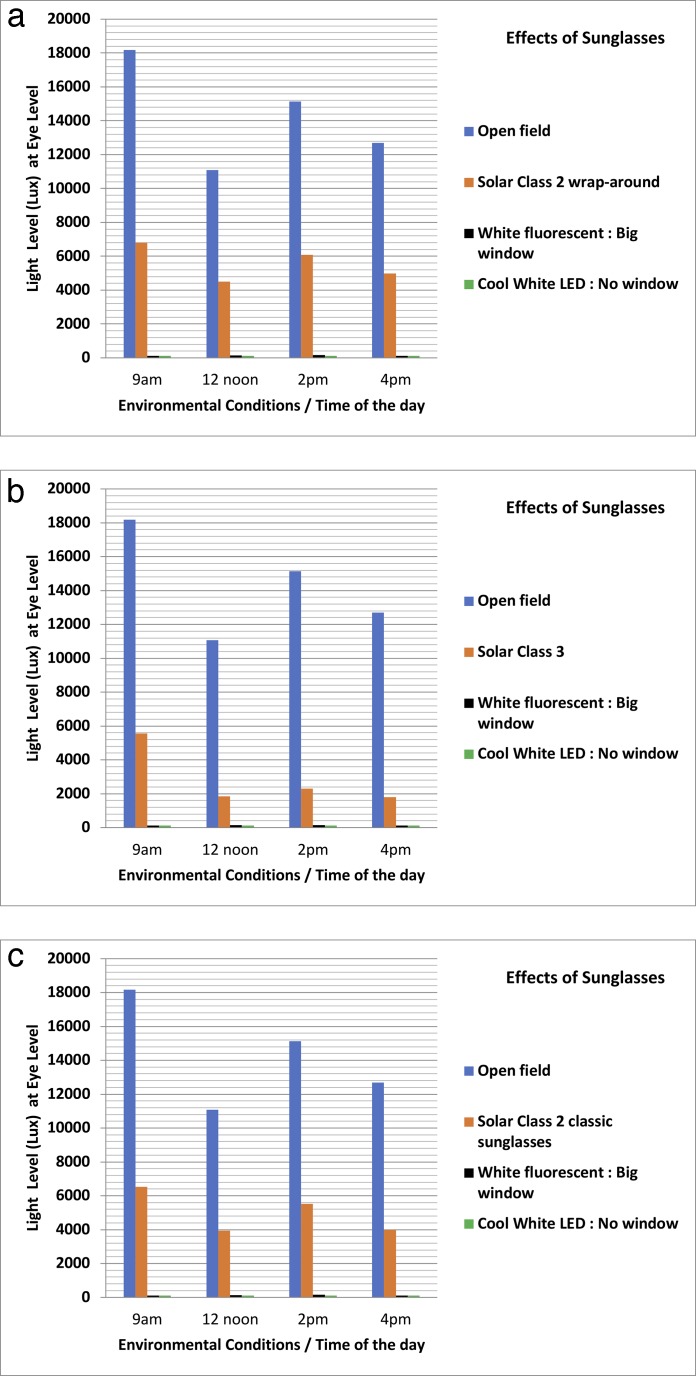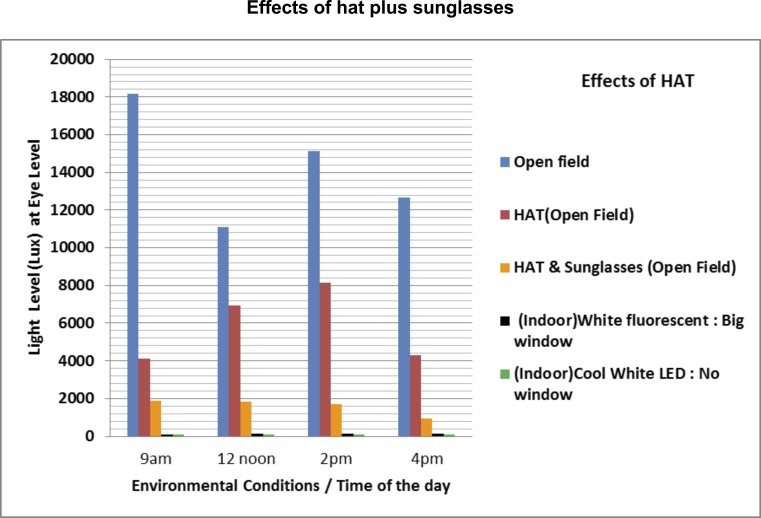Abstract
Purpose
Lack of outdoor time is a known risk factor for myopia. Knowledge of the light levels reaching the eye and exposure settings, including sun-protective measures, is essential for outdoor programs and myopia. We evaluated the impact of sun-protective strategies (hat and sunglasses) on maintaining high illuminance levels to prevent myopia.
Methods
A child-sized mannequin head was developed to measure light illuminance levels with and without sun-protective equipment, across a wide range of environments in Singapore, outdoors (open park, under a tree, street) and indoors (under a fluorescent illumination with window, under white LED-based lighting without window). A comparison was made between indoor and outdoor light levels that are experienced while children are involved in day-to-day activities.
Results
Outdoor light levels were much higher (11,080–18,176 lux) than indoors (112–156 lux). The higher lux levels protective of myopia (>1000 lux) were measured at the tree shade (5556–7876 lux) and with hat (4112–8156 lux). Sunglasses showed lux levels between 1792 and 6800 lux. Although with sunglasses readings were lower than tree shade and hat, light levels were still 11 to 43 times higher than indoors.
Conclusions
Recommendations on spending time outdoors for myopia prevention with adequate sun protection should be provided while partaking in outdoor activities, including protection under shaded areas, wearing a hat or sunglasses, sunscreen, and adequate hydration.
Translational Relevance
Light levels outdoors were higher than indoors and above the threshold illuminance for myopia prevention even with adequate sun-protective measures.
Keywords: myopia, light levels, children, outdoor activities, prevention
Introduction
Increasing time outdoors has been protective against myopia, delaying its onset in children.1–5 Population-based studies report that children in Asian countries, especially of Chinese ethnicity, have higher myopia prevalence compared to those in Western countries.6 The prevalence of myopia in 6- and 7-year-old children of Chinese ethnicity was significantly lower in Sydney (3.3%) than in Singapore (29.1%), while patterns of daily outdoor light exposure showed that children living in Singapore were exposed to significantly less daily outdoor light than Australian children.7,8 In Australian children aged 10 to 15 years, greater daily light exposure was associated with less ocular axial length over an 18-month period.9 Studies in Taiwanese children also showed that myopia progression can be diminished by increasing outdoor time.3,4 Exposure to outdoor light led to less myopic shift, less axial elongation and a 54% lower risk of rapid myopia progression.3 These findings support a role of light exposure in childhood myopia prevention. Combined with less outdoor activity, other factors, including increased indoor studying, maternal myopia, and residing in an urban region, have been reported to be associated with longer ocular axial length and myopia.10
One hypothesis that explains why bright light decreases the risk of myopia development is an increased release of dopamine, a neurotransmitter found in the retina, that is responsible for retinal signaling and can influence refractive development.11 New evidence also implicates diurnal and circadian rhythms in eye growth and refractive error development.12 The translatability of these research findings in human populations remains unknown as human eyes are anatomically different from animal models.
Outdoor illuminance levels vary significantly depending on weather, geographic location, and elevation, with illuminance levels reaching 130,000 lux on a clear day to 15,000 lux under shaded or cloudy conditions.13 Regardless, this is a stark contrast to the typical indoor illuminances achieved that are a few hundred lux.3,14 High illuminances outdoors are protective against myopia in children, while excessive ultraviolet (UV) light may predispose them to cataract, pterygia, and macular toxicity later in adult life.15 Countries, such as Singapore16 and China,1 among others, are implementing outdoor activity programs to prevent myopia and protective measures against sunlight damage must be accounted for. To the best of our knowledge, no studies have evaluated whether hats and sunglasses may diminish the beneficial effects of outdoor time in the prevention of myopia. Thus, our objective was to evaluate the impact of sun-protective strategies on maintaining high illuminance levels (measured in lux) to prevent myopia.
Methodology
The Mannequin
Two bespoke child-sized mannequin heads of children were designed to accurately record visible light illuminance levels incident on the human eye. Taking into consideration the structure of a children's face, the optical sensors were embedded into the head and shielded by a brow ridge. The forehead, nose, and ears were retained to enable the use of sun-protection accessories. The head model was mounted on a tripod stand, such that the height of the model was 137 cm to represent the 50th percentile height of a 10-year-old child in Singapore.17 The limitations of existing light measurement systems make it challenging to measure incident illuminance levels on children's eye, while simultaneously accommodating sun-protective equipment, such as sunglasses and hats.
The left and right eyes of the mannequin head accommodated an AMS TSL45315 ambient light sensor (AMS AG, Premstaetten, Austria). The ambient light sensor was selected because it closely matched the photopic vision of the human eye, with direct illuminance response in an ideal range of 3 to 220,000 lux.18
Two identical mannequin heads were manufactured. One head was designated as a control unit, while the other was designated as the measurement unit. To minimize error in data collection, readings were recorded simultaneously from both mannequins using logging buttons. This minimized error from the day arc and its effects on the directionality of sunlight, as well as cloud variation. The control mannequin was used to measure baseline light illuminance levels, whereas the other mannequin head measured light levels with adapted sun-protective measures (Fig. 1). The protective eye measures included a hat and three types of sunglasses, which were studied separately and in combination.
Figure 1.
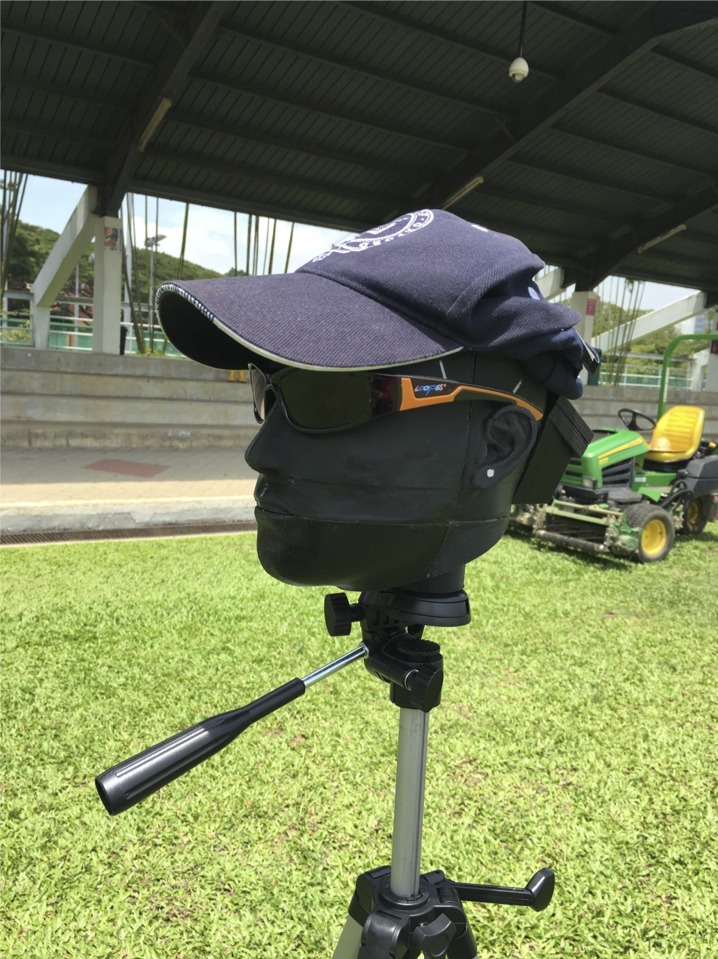
Protective eye measures (hat and sunglasses).
When subjected to various outdoor lighting conditions, the ambient light readings from the two mannequins varied within ±1% of each other. The difference was postulated to arise from manufacturing tolerances and sensor positioning, as the sensors cannot be placed exactly in the same location and were placed side by side to record incident light simultaneously. However, the percentage difference across the two sensors was very small so sensors can be regarded as identical within limits of experimental accuracy.
The mannequin heads also were tested indoors, measuring light illuminance levels when facing a window under a fluorescent lighting and without window under a cool white light-emitting diode (LED). These measurements were compared to outdoor light illuminance levels, to evaluate the difference between the two environments.
Test Environments
Three outdoors test environments were investigated, in an open field (Fig. 2a), street (Fig. 2b), and under a tree (Fig. 2c) to comply with the most common daily outdoor activities.
Figure 2.
Three outdoor test environments investigated, in an open field (a), street (b), and under a tree (c).
The two mannequin heads were oriented southward, and light illuminance levels were measured under various combinations of test environments, with and without sun-protective equipment. Four different times of day were selected for conducting the measurements (9 AM, and 12, 2, and 4 PM), each representing a different relative position of the sun. The measurements were made under cloudy or partially cloudy environments, representing the most common weather in Singapore. Two indoor environments also were tested, in a room under a fluorescent lamp illumination and with natural light from a window and a room under a cool withe LED without window.
Sunglasses
Three different types of brown sunglasses were used ranging from 8% to 43% of transmission (transmittance in accordance with the international standard ISO 12312-1:2013, Clause 519). There were two sunglasses with classic frame (Solar Class 2 and 3) and 1 with a wraparound frame (Solar Class 2). The main benefit of the wraparound is to minimize back reflection of UV radiation, which forms an important share of the UV burden to the eye.15
Hat
A baseball cap providing protection for forehead, cheeks, and nose was used for this study. This was a soft cap with rounded crown and a stiff peak projecting in front (Fig. 1). The hat was tested in the different environments alone and in conjunction with sunglasses.
Statistical Analysis
All light illuminance levels values in lux were collected from the mannequin, and data were presented descriptively for each test situation and timing. Microsoft Excel 2010 was used.
Results
Outdoor Versus Indoor
Outdoor conditions in the open field environment showed much higher illuminance levels (11,080–18,176 lux) compared to indoors (Fig. 3). Indoor levels fluctuated from 112 to 156 lux under a fluorescent lamp illumination and with natural light from a window. The indoor lux levels under a cool LED without window were consistent at 112 lux at all four timings of measurement (from 9 AM to 4 PM).
Figure 3.
Light illuminance levels, comparing measurements in an open field, under a tree, and indoors.
Shade Provided by Tree
Figure 3 compares the effect of shade provided by trees (ranging from 5556–7876 lux) with typical lighting conditions at various times of the day in an open field with cloudy conditions (ranging from 11,080–18,176 lux) and indoor levels (112–156 lux). Tree shade provided at least 50 times more myopia protection with an increase in light illuminance levels compared to the indoor measurements. Figure 4 compares the typical street lighting conditions at various times of the day (ranging from 6604–16,320 lux) with open field conditions and indoors. Compared to the tree shade, street lighting conditions fluctuated depending on the buildings in proximity and the day arc.
Figure 4.
Light illuminance levels, comparing measurements in an open field, next to a street, and indoors.
Sunglasses
Figures 5a to 5c show how different types of sunglasses (n = 3) can provide higher light illuminance levels (ranging from 1792–6800 lux) reaching the eye compared to indoors. The light levels with the sunglasses tested were approximately 11 to 43 times higher than the indoor environment. This variation was attributed to the specifications of the sunglasses, with different lenses providing different sun glare protection and luminous transmittance. However, even with sunglasses, the light levels remained considerably higher (≥1792 lux) compared to indoor lighting conditions (112–156 lux). The highest illuminance levels were achieved by the Solar class 2 lenses (wraparound, Fig. 5a, 4496–6800 lux; classic, Fig. 5c, 3952–6528 lux). The Solar Class 3 (classic, Fig. 5b), with light levels ranging from 1792 to 5552 lux, also were able to display bright light, while maintaining outdoor levels.
Figure 5.
Light illuminance levels, comparing measurements in an open field, with and without (a) solar Class 2 wrap-around, (b) solar Class 3 (classic), and (c) solar Class 2 (classic) sunglasses.
Hat
The effects of wearing a hat are shown in Figure 6 (ranging from 4112–8156 lux), where the hat alone provided an increase between 26 to 52 times in light illuminance levels, compared to indoor levels of 112 to 156 lux. The baseball hat provided sufficient light levels for myopia prevention with maximum exposure levels of 8156 lux at 2 PM.
Figure 6.
Light illuminance levels, comparing measurements in an open field with a hat and with a hat and sunglasses.
Hat and Sunglasses
With hat and sunglasses, the light levels ranged from 952 to 1880 lux. Compared to indoors, light levels with hat and sunglasses were only 6 to 12 times higher. The large range in light illuminance with the hat alone was attributed to the directionality of sunlight at different times of the day. The effect of sunlight directionality on light illuminance levels diminished when wearing sunglasses. At 4 PM combining the hat with glasses reduced the light intensity exposure close to indoor values (952 lux).
Discussion
Summary
Our study provided evidence that sun-protective strategies, such as tree shade (5556–7876 lux), hat (4112–8156 lux), and sunglasses (1792–6800 lux) can maintain high potentially protective illuminance levels for myopia outdoors. Our results supported the potential for interventions aimed at increasing average daily light exposure to reduce the progression of childhood myopia, while engaging in sun-protective measures that reduce UV levels to prevent future cataract. The results also helped to improve our understanding of the potential magnitude of the effects of such measures on corneal illuminances.
Outdoor Versus Indoor
Light recordings at the open field (11,080–18,176 lux) were much higher compared to indoors (112–156 lux). All indoor levels were below outdoors and cannot be considered protective from myopia. Even in the room where there was natural light from a window, the maximum lux level was only 156 lux. Different lighting between the rooms and presence/absence of a window does not seem to have a significant impact on lux levels that remained relatively stable throughout the four timings of measurement. This result might be similar in classrooms at school even if windows are present, showing that siting children next to a window does not provide enough light exposure against myopia. Although schools with large windows were evaluated previously for myopia prevention, evidence that daylight in classrooms prevents myopia is lacking.20
The lux readings found indoor in our study were lower than the classroom readings in the Taiwan study (340 lux).3 However, average light levels in school classrooms can vary widely between 138 and 742 lux, as reported by a study in the United Arab Emirates.21 Still, even the reported higher indoor readings in classrooms were less than the threshold of 1000 lux and do not have preventive myopia potential. This topic warrants further research on light levels in classroom indoor environments in Singapore and comparisons with other countries.
Our findings of low levels of light intensity indoors must be further investigated, as a previous study showed that chickens raised under low-intensity levels (50 lux) had a deeper vitreous chamber depth and a longer axial length.22 Further research is advised as low intensity ambient light might be a risk factor for myopia.
Shade Provided by Tree
Light levels in shaded outdoor areas remained considerably elevated (5556–7876 lux) and yielded a good potential for delaying the onset of myopia. Measurements under a tree shade showed that light levels were 50 times higher and potentially protective for myopia than indoor levels. This finding on the shade also is important for eye protection, reducing the risk of side effects due to bright light exposure. According to Wu et al.,3 outdoor activities with strong sunlight exposure (≥10,000 lux) may not be necessary for myopia prevention and relatively lower outdoor light intensities (1000–3000 lux or more) with longer time outdoors, such as in hallways or under trees, also can be considered. This finding is corroborated by a significant reduction in the myopic shift in children with 200 minutes of outdoor time exposure to ≥1000 or ≥3000 lux. Read et al.9 also confirm these findings reporting that children exposed to light levels >3000 lux per day had significantly less axial eye growth.
The effect of trees reducing UV radiation, including the scattered individual trees in urban settings, is well documented in the literature.23 However, the effect of tree shade on light levels is less known. Levels above 5000 lux can be achieved easily in conditions, such as in the hallway from a school or under the shade of a tree (5556–7876 lux) that are much higher than indoors (112–156 lux), as shown in our study. Several benefits are provided by trees, including the reduced glare, blocking the diffused light from the sky and other surfaces, and contribution to control the ambient temperature by blocking heat.24
Street levels were higher than shade provided by trees and light levels ranged from 6604 to 16,320 lux. Shade provided by the buildings at the street can reach similar levels of the open field due to diffuse light and heat reflected from sunlit surfaces.24 In a randomized clinical trial in Taiwan, children who spent 125 to 199 minutes outdoors showed significant less myopic shift if exposed to bright levels of 10,000 lux or more.3 Although, outdoor levels can reach much higher bright levels than measured in our study (maximum of 18,176 lux), the weather conditions may change the light intensity as Singapore experiences cloudy conditions for 8.8 months in the year, with partly cloudy conditions reaching 24% of the time during March. Overcast conditions are present 76% of the time during March and 91% in December.25 However, even with cloudy conditions, the light levels outdoors override the indoor levels, providing sufficient evidence for increasing outdoor exposure in Singaporean children.
Sunglasses
The light levels measured with sunglasses were approximately 11 to 43 times higher than indoor environments. The sunglasses lenses tested were able to produce an acceptable increase in bright light compared to indoors showing a potentially protective effect against myopia. Sunglasses provided a vertical protection barrier to the eyes and effectiveness depends on geometry, lenses radiation transmittance, and exposure conditions.26 The effect of sunglasses alone was not the same across different categories of lenses. Solar class 2 (wraparound and classic) lenses showed higher readings of light levels. The Solar Class 3 (classic) lenses drastically reduced outdoor illuminances at the eye level especially at 12 PM and 4 PM. These sunglasses are not advisable to be used by children outdoors as they limit the protective effect of light for myopia prevention. Currently, there is no evidence whether wearing sunglasses hinders the protective effect of bright light as the subject has not been studied systematically. Our results support that children could be encouraged to spend more time outdoors with adequate UV protection, such as sunglasses. A previous study reported that use of sunglasses ranged from “never” to “half the time” (median response was “never”) in children 10 to 15 years old and the use did not differ significantly between the myopic and nonmyopic children.9
Hat
The present study also showed that if a child spends time outdoors, using a hat, the light levels outdoors (4112–8156 lux) remained much higher than indoors and, thus, may prevent the development of myopia. The hat alone provided an increase between 26 to 52 times in light illuminance levels compared to indoors. A previous study found that the reported frequency of hat use when outdoors ranged from “never” to “all the time” (median response was “less than half the time”) and use did not differ significantly between the myopic and nonmyopic children.9
Protection of children's eyes from UV radiation is particularly important, since UV transmittance is higher at a very young age, allowing higher levels of UV radiation to reach the crystalline lens and even the retina.15 According to the American Academy of Pediatrics, clothing (including hats with brims) can be an excellent UV radiation barrier, because it offers a simple and practical means of sun protection.27 The wide-brimmed hats are more protective to the head, face, ears, and neck.28 When using a baseball cap, sunscreen should be added to ears and neck.
Hat and Sunglasses
Light levels with a combination of hat and sunglasses might be only borderline protective against myopia as exposure levels were between 952 and 1880 lux. Exposures above 2000 lux were not measured and combined use of hat and sunglasses cannot be recommended for myopia protection according to our findings. However, more research is needed to identify the impact of combined sun-protective measures on light levels.
Advantages and Limitations
One advantage of this study was the development of the child's mannequin head and light sensor, which was able to measure illuminance ranges at the eye level. The use of the mannequin heads of children allowed accurate recordings of illuminance light levels at a plane incident to the human eye, without the advantage of exposing children to UV light in open field conditions. A limitation was that light intensity levels might have been different with different angles of gaze, in other settings (e.g., school) and timings of the month due to monthly change in cloudy conditions in Singapore.
Public Health Implications
Behavioral interventions can be of particular interest for children with myopia, avoiding or delaying the use of other treatment options with side effects, such as atropine and orthokeratology. As a guideline, children should engage in outdoor activities for at least 2 to 3 hours per day and at least 14 to 21 hours per week. Less than 40 minutes per day of bright light exposure may predispose children to faster axial eye growth.9
Our results have important public health implications for outdoor programs. Teachers, educators, and parents should stimulate children to be exposed outdoors with shade, sunglasses, or hat protection. Approaches, such as that outlined here, may offer a practical alternative to delivering relatively high-intensity light exposures for longer periods of time, thus potentially effecting greater reductions in myopia risk. Schools have a major role in influencing children's knowledge, attitudes, and behavior regarding outdoor programs. Teachers can make a major contribution to myopia prevention, combining myopia prevention strategies with sun-protective measures during weekdays, especially in the course of recess time, lunch breaks, and possible extend outdoor programs further to curriculum hours. School-based initiatives outdoors can be conducted during assembly, regular classes, and physical education classes, as occurs in Australian schools.8
The availability of shade structures at schools and daycare centers is likely to help in myopia prevention and reduce children's UV radiation dose significantly. Parent and community involvement in healthy dual sun-protective practices during weekends is more likely to take place if there is consistent information and support from the family, school, and community.
Conclusion
Exposure to light levels outdoors was considerably higher than indoors even while wearing sunglasses, a hat, or being in the shade. Children should be encouraged to spend more time outdoors while using sun-protection measures to prevent myopia. Our results can facilitate public health efforts to encourage outdoor activities and raise awareness about the importance of sun protection measures to reduce UV damage while increasing protection against myopia onset.
This work warrants further developments and studies to test the effectiveness of sunglasses and hats as protective measures in nationwide outdoor programs to prevent myopia. The knowledge of light exposure patterns achieved with sun-protective measures can be a crucial factor in the design of outdoor programs and needs further research.
Acknowledgments
Supported by Essilor R&D, Center for Innovation and Technology, Evaluation of the effect of sunglass protection on light illuminance levels.
Disclosure: C. Lanca, None; A. Teo, None; A. Vivagandan, None; H.M. Htoon, None; R.P. Najjar, None; D.P. Spiegel, Essilor International, Singapore (E); S.-H. Pu, None; S.-M. Saw, None
References
- 1. Jin J-X, Hua W-J, Jiang X, et al. Effect of outdoor activity on myopia onset and progression in school-aged children in northeast china: the sujiatun eye care study BMC Ophthalmol 2015. 15 73. [DOI] [PMC free article] [PubMed] [Google Scholar]
- 2.He M, Xiang F, Zeng Y, et al. Effect of time spent outdoors at school on the development of myopia among children in China: a randomized clinical trial. JAMA. 2015;314:1142–1148. doi: 10.1001/jama.2015.10803. [DOI] [PubMed] [Google Scholar]
- 3.Wu P-CP-C, Chen C-TC-Y, Lin K-K, et al. Myopia prevention and outdoor light intensity in a school-based cluster randomized trial. Ophthalmology. 2018;125:1239–1250. doi: 10.1016/j.ophtha.2017.12.011. [DOI] [PubMed] [Google Scholar]
- 4.Wu P-C, Tsai C-L, Wu H-L, Yang Y-H, Kuo H-K. Outdoor activity during class recess reduces myopia onset and progression in school children. Ophthalmology. 2013;120:1080–1085. doi: 10.1016/j.ophtha.2012.11.009. [DOI] [PubMed] [Google Scholar]
- 5.Xiong S, Sankaridurg P, Naduvilath T, et al. Time spent in outdoor activities in relation to myopia prevention and control: a meta-analysis and systematic review. Acta Ophthalmol. 2017;95:551–566. doi: 10.1111/aos.13403. [DOI] [PMC free article] [PubMed] [Google Scholar]
- 6.Pan C-W, Ramamurthy D, Saw S-M. Worldwide prevalence and risk factors for myopia. Ophthalmic Physiol Opt. 2012;32:3–16. doi: 10.1111/j.1475-1313.2011.00884.x. [DOI] [PubMed] [Google Scholar]
- 7.Rose KA, Morgan IG, Smith W, Burlutsky G, Mitchell P, Saw S-M. Myopia, lifestyle, and schooling in students of Chinese ethnicity in Singapore and Sydney. Arch Ophthalmol. 2008;126:527–530. doi: 10.1001/archopht.126.4.527. [DOI] [PubMed] [Google Scholar]
- 8. Read SA, Vincent SJ, Tan CS, Ngo C, Collins MJ, Saw SM. Patterns of daily outdoor light exposure in Australian and Singaporean children Transl Vis Sci Technol 2018. 7 8. [DOI] [PMC free article] [PubMed] [Google Scholar]
- 9.Read SA, Collins MJ, Vincent SJ. Light exposure and eye growth in childhood. Invest Ophthalmol Vis Sci. 2015;56:6779–6787. doi: 10.1167/iovs.14-15978. [DOI] [PubMed] [Google Scholar]
- 10.Guo Y, Liu LJ, Xu L, et al. Outdoor activity and myopia among primary students in rural and urban regions of Beijing. Ophthalmology. 2013;120:277–283. doi: 10.1016/j.ophtha.2012.07.086. [DOI] [PubMed] [Google Scholar]
- 11.Zhou X, Pardue MT, Iuvone PM, Qu J. Dopamine signaling and myopia development: what are the key challenges. Prog Retin Eye Res. 2017;61:60–71. doi: 10.1016/j.preteyeres.2017.06.003. [DOI] [PMC free article] [PubMed] [Google Scholar]
- 12.Chakraborty R, Ostrin LA, Nickla DL, Iuvone PM, Pardue MT, Stone RA. Circadian rhythms, refractive development, and myopia. Ophthalmic Physiol Opt. 2018;38:217–245. doi: 10.1111/opo.12453. [DOI] [PMC free article] [PubMed] [Google Scholar]
- 13.Norton TT, Siegwart JT. Light levels, refractive development, and myopia – A speculative review. Exp Eye Res. 2013;114:48–57. doi: 10.1016/j.exer.2013.05.004. [DOI] [PMC free article] [PubMed] [Google Scholar]
- 14.Dharani R, Lee CF, Theng ZX, et al. Comparison of measurements of time outdoors and light levels as risk factors for myopia in young Singapore children. Eye. 2012;26:911–918. doi: 10.1038/eye.2012.49. [DOI] [PMC free article] [PubMed] [Google Scholar]
- 15.Behar-Cohen F. Baillet, De Ayguavives, et al. Ultraviolet damage to the eye revisited: eye-sun protection factor (E-SPF®), a new ultraviolet protection label for eyewear. Clin Ophthalmol. 2014;8:87–104. doi: 10.2147/OPTH.S46189. [DOI] [PMC free article] [PubMed] [Google Scholar]
- 16.Dirani M, Tong L, Gazzard G, et al. Outdoor activity and myopia in Singapore teenage children. Br J Ophthalmol. 2009;93:997–1000. doi: 10.1136/bjo.2008.150979. [DOI] [PubMed] [Google Scholar]
- 17.Health Promotion Board. Health Booklet. Singapore: 2014. 2018. Available at: https://www.healthhub.sg/sites/assets/Assets/Programs/screening/201810/pdf/health-booklet-2014.pdf. Accessed November 21, [Google Scholar]
- 18.ROHM. ROHM Semiconductor ML8511 UV Sensor with Voltage Output. 2015. Availale at: https://www.rohm.com/documents/11303/4214223/FEDL8511A-02-e.pdf.
- 19.International Organization for Standardization. Eye and Face Protection—Sunglasses and Related Eyewear—Part 1: Sunglasses for General Use. ISO 12312-1, London: International Organization for Standardization. 2013.
- 20.Hobday R. Myopia and daylight in schools: a neglected aspect of public health? Perspect Public Health. 2016;136:50–55. doi: 10.1177/1757913915576679. [DOI] [PubMed] [Google Scholar]
- 21.Fadeyi MO, Alkhaja K, Sulayem M, Bin Abu-Hijleh B. Evaluation of indoor environmental quality conditions in elementary schools' classrooms in the United Arab Emirates. Front Archit Res. 2014;3:166–177. [Google Scholar]
- 22.Cohen Y, Belkin M, Yehezkel O, Solomon AS, Polat U. Dependency between light intensity and refractive development under light–dark cycles. Exp Eye Res. 2011;92:40–46. doi: 10.1016/j.exer.2010.10.012. [DOI] [PubMed] [Google Scholar]
- 23.Na HR, Heisler GM, Nowak DJ, Grant RH. Modeling of urban trees' effects on reducing human exposure to UV radiation in Seoul, Korea. Urban For Urban Green. 2014;13:785–792. [Google Scholar]
- 24.Abdel-Aziz DM, Shboul A Al, Al-Kurdi NY. Effects of tree shading on building's energy consumption - the case of residential buildings in a mediterranean climate. Am J Environ Eng. 2015;5:131–140. [Google Scholar]
- 25.Spark W. Average weather in Singapore. Available at: https://weatherspark.com/y/114655/Average-Weather-in-Singapore-Year-Round. Accessed November 22. 2018.
- 26.Backes C, Religi A, Moccozet L, et al. Sun exposure to the eyes: predicted UV protection effectiveness of various sunglasses. J Expo Sci Environ Epidemiol. 2018. [published online ahead of print October 31, 2018] [DOI] [PMC free article] [PubMed]
- 27.Balk SJ. Ultraviolet Radiation: A hazard to children and adolescents. Pediatrics. 2011;127:e791–e817. doi: 10.1542/peds.2010-3502. [DOI] [PubMed] [Google Scholar]
- 28.D'Orazio J, Jarrett S, Amaro-Ortiz A, Scott T. UV. Radiation and the skin. Int J Mol Sci. 2013;14:12222–12248. doi: 10.3390/ijms140612222. [DOI] [PMC free article] [PubMed] [Google Scholar]



